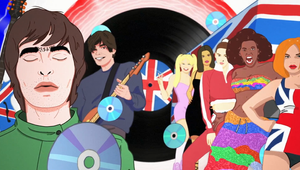
Animate! Why Inspiration Is Everywhere with Christine Peters

Christine Peters is a lead 2D animator at London-based animation studio, Blind Pig. Christine creates hand-drawn and digital illustrations, animating them digitally using Toon Boom, TVPaint and Photoshop.
Christine joined Blind Pig in 2015 and has built a diverse portfolio comprising character design, frame-by-frame animation and stylised motion design. She has crafted campaigns for the likes of Boots, Netflix, Nissan and Microsoft and has a penchant for overseeing the entire animation process, from storyboarding, to design, development and animation.
LBB> How did you fall in love with animation?
Christine> I’ve loved 2D animation ever since I can remember. As a child, I became obsessed with my parents’ favourites, like ‘The Magic Roundabout’, ‘Funny Bones’, ‘Looney Toons’ and ‘Ren & Stimpy’, as well as all the Disney classics. One of my earliest memories is drawing one of my stuffed toys over and over again to try and make it animate. Obviously, that didn’t work out, but a few decades later it is now my job!
LBB> Tell us about the animation project that kick started your career?
Christine> Architecture for Humanity – a charity which asked designers and architects to design a postcard concept to make London a better city. The winning design was The Bounceway – a trampoline highway that would span across London.
I was tasked with making an animated teaser for it.
Fresh out of university with only the basics of animation under my wing, I totally winged it, learning multiple new techniques and figuring out how to rig and animate my illustrations with the sketch and toon function in Maya. The animation aired on The BBC news, after the designers leaked the plans to the press and lost the funding... SCANDALOUS!
It didn’t necessarily kickstart my career, but it definitely made it clear animation was for me.
LBB> How would you describe your art style and what are your biggest inspirations that developed it?
Christine> I’ve been at Blind Pig for over eight years and the best thing about it is the range of projects I get to work on. I’ve done loose, sketchy line illustrations, full on ink drawings and watercolour paintings – bringing them all to life through animation. For me personally, a true favourite will always be drawing characters in a fine line Anime or Disney-esque style. I studied architecture at university, which instilled in me a bit of a complex about line and line weight in general. Consistency and variation is key... (massive oxymoron right there!)

Above – Christine working on Nissan - Design In Motion
LBB> From your perspective, what’s the key to animation that really lives?
Christine> In character animation, a really strong set of posing at the beginning is key for animation that comes ALIVE. Nailing the gesturing and acting relies so heavily on this. We spend a lot of time acting out how we want the character to behave, a lot of reference videos help me pick out the elements in the performance to emphasise and recreate.
LBB> Show us your favourite or most impactful project that you’ve worked on - tell us, what is it that makes it special and what were the memorable moments or challenges?
Christine> One of my favourite projects to have worked on recently has been Arden University - I loved every stage of working on it. It’s called ‘Silence Your Inner Critic’, and the main character is the sort of know-it-all imposter that many of us have known all too well. It was so satisfying to take a sketch of a character through to completion where he’s walking, talking and... mocking... on screen.
Another highlight was the ‘Stranger Things Season 1 recap’, which went live on their social media channels pre season four and incited mass fan hysteria. We wrote scripts and pitched to Netflix, taking it all the way from character design to animation and compositing. Having ‘90s icon Winona Ryder signing off her character sheet I’d drawn was unreal. As was the retweet from Matthew Modine who stars in it.
A lot of my favourite projects that have been most impactful have been made in collaboration with charities such as Unicef’s ‘End Violence’ featuring David Beckham and Boots’ Christmas film, ‘Happy’.
LBB> How do you approach character design? What is your creative process like? Show us some of your favourite characters and their journey from notepad to screen.
Christine> For brand new characters, I start by defining them. What drives them? What are their likes and dislikes? Where are they from? What are their gestures and mannerisms? And most importantly: what do I need them to convey in the animation?
Sometimes, characters are based on existing protagonists – like in our Stranger Things Teaser. When matching a real-life character’s likeness, it doesn’t need to be a direct representation. But it does need to capture the essence of the person.


Above: Character designs for Netflix’ Stranger Things Recap Season 1
LBB> Tell us more about observation and movement - what is the process you go through to study movement of characters?
One of my favourite characters we’ve designed and animated lately is Tarquin, who is the star of the Arden University spot we recently completed. We brainstormed who he was and why he was behaving the way he does in the script, chatting this all through with the agency.
At the concept stage, we started to develop how the poses would work in the scenes and how his behaviour negates his miniature stature. Next, we look at acting out filmed references to nail the performance, as well as finding existing references from theatre clips, TV shows and film. We also had the footage from the voiceover actor to aid us in animating the performance and the delivery of his lines. When lip-syncing, I still have the habit of making the facial expressions of what I’m trying to draw - a bit hard to do with a full pose, though.


Above: Initial character designs for Arden Silence Your Inner Critic
LBB> We all know of some ever-green adult animations, but lately they have definitely been on the rise, from Rick and Morty to Arcane. What sort of opportunities does this open for animators, both within and outside the advertising industry?
Christine> I love the rise in animation targeted towards an adult audience. The more mainstream it becomes, the better for the industry as a whole, creating more opportunities not just in jobs but also in narratives. We recently attended Annecy Animation Festival for the first time as a studio; it was a joy to see all manner of stories being told through unique and diverse perspectives.
LBB> How does one figure out what kind of animation style or styles fits a particular story or project?
Christine> With animation, you can give life to inanimate objects and literally play God. It comes down to a few things - what is the story being told, who is the story being aimed at and what is the preference of the client? Certain styles of animation are seen as more childlike, which is often more palatable, or it may be more adult oriented and comedic.
LBB> What is your favourite piece of technology or software that you use and how does it help your creative process?
Christine> We use a wide breadth of programmes to match the breadth of animation styles we execute. In 2D, Toon Boom, TVPaint and Photoshop are the go-tos, and in the past it was mostly Animate.
My personal favourite is TVPaint, I always find it more intuitive when animating frame-by-frame animation and sketching out ideas. I’ve built up a good-sized library of different paint brushes over the years and unfortunately, I can’t take that into other animation softwares. We are using Toon Boom more and more, as it is better equipped at dealing with longer form animation, with utilities such as sharing animation assets, easy to change colour palettes and puppet rigging with artwork.
LBB> What sort of briefs or projects do you find more personally satisfying to work on?
Christine> The most satisfying projects are those I get to work on from the earliest stages, such as script and storyboarding the concept, all the way through to the animation and compositing.
As well as Stranger Things, iconic foodie influencer, What Willy Cook’s music video for Kellogg's Crunchy Nut is a fun example. It’s catchy AF with some Honey I Shrunk The Kids animated comedy. Think life-sized squirrels and angry charging bees. I really got to run with the concept designs and take it as far as I could.
LBB> What recent projects have really stood out for you and why?
Christine> I’ve had a really good run of interesting creative projects in the past year and a half - What Willy Cook was so entertaining to work on, Nissan ‘Pole to Pole’ I got to really hone in on one of my favourite art styles and creating the performance for Arden University critic Tarquin was a total joy.
LBB> Who is your animation hero and what is it about their work that inspires you? What example of their work particularly stands out?
Christine> I know it’s cliché but my heroes have to be Richard Williams and Hayao Miyazaki. Williams’ book, The Animator’s Survival Kit, taught me how to animate, and Hayao Miyazaki’s work really influenced me wanting to become an animator, as well as the Disney classics we all grew up with.
LBB> Outside of the field of animation, what really inspires you?
Christine> Everything. The world around me, TV, film, social media, books and life experiences.
LBB> What do you think are the misconceptions about animation throughout the industry?
That it is only for children. A whole lot of animation is aimed purely at adults, from film, to TV series and advertising. There is a huge demand for it, and that largely comes down to script writing, not art style.
LBB> What are the biggest changes to animation and challenges facing animators at the moment and what are your thoughts on them?
Christine> From an educational point of view, the rise in tuition fees and student loan repayment terms will impact who gets to train as an animator in general. As an industry, we should be finding different ways to get new talent into the industry through nontraditional university routes.
When I was starting out, I would have loved to have been an apprentice at a studio and studied part time. As a studio, we’re passionate about offering students advice, whether that’s in the office, or at careers fairs like Creative Circle’s annual event.
LBB> Any advice you would like to give to aspiring artists?
Christine> Hone in on the type of work you love doing most and demonstrate it clearly in your portfolio/socials/CV. Use the resources at your disposal to train and find people who work in what you are interested in getting into.
Attend animation festivals and showcases; well-known ones held monthly are See No Evil which showcases one or two studios/artists, It’s Nice That holds Nicer Tuesdays consisting in talks from an array of designers, animators and illustrators etc. Also keep an eye out for mentorship schemes in your area.













